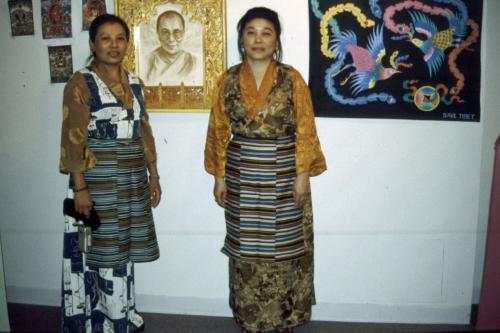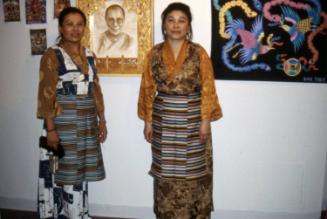Aid to Artisans Gathering, 1999
SubjectPortrait of
Tsultim Lama
(Tibetan)
SubjectPortrait of
Tsering Yangzom
(Tibetan)
SubjectPortrait of
Ursula Brodowicz
(Polish)
SubjectPortrait of
Manola Sidara
(Laotian)
Date1999 November 6
Mediumborn digital photography
ClassificationsGraphics
Credit LineConnecticut Cultural Heritage Arts Program collections
CopyrightIn Copyright
Object number2015.196.662.6-.11
DescriptionPhotographs from an Aid to Artisans Gathering in September 1999.
(.6) Tibetan artists Tsultim Lama and Tsering Yangzom at an Aid to Artisans gathering at the Institute for Community Research in Hartford.
(.7) Polish educator and artist Ursula Brodowicz describes a Polish embroidered vest worn by folk dancers at an Aid to Artisans gathering at the Institute for Community Research in Hartford.
(.8) Manola Sidara describes her Lao pah khuane ceremonial ornaments at an Aid to Artisans gathering at the Institute for Community Research in Hartford.
(.9) Artists are listening to other artists describing their work at an Aid to Artisans gathering at the Institute for Community Research in Hartford.
(.10-.11) Manola Sidara describes her Lao pah khuane ceremonial ornaments at an Aid to Artisans gathering at the Institute for Community Research in Hartford.
NotesSubject Note: On November 6, 1999, CCHAP hosted Aid to Artisans (ATA), a Farmington-based arts marketing organization, at a gathering of Connecticut artists working in folk and traditional art forms. The goal of the event was to introduce ATA to 20+ folk and traditional artists working in Connecticut and with CCHAP in various communities across the state. Other goals were to increase awareness and appreciation of hand crafted ethnic and heritage art forms and to provide an opportunity for artisans to develop strategies for marketing, promotion, and cultural tourism. The event was hoped to be a way to support the planning and implementation of a heritage artisans enterprise development project for and with Connecticut traditional artists/craftspeople. Activities held during the day included informal, roundtable discussions among all the artists; an exhibition of artists’ work in ICR’s gallery; professional photography of the artists’ work by Phillip Fortune; and a pot luck supper. The collaboration with ATA did not develop into a larger marketing project, largely because the artists could not commit to full-time work creating and producing enough items for the scale of sales that ATA required – most folk and traditional artists work other jobs and typically do not have enough resources for uncertain arts production. Also, the design concepts required by ATA’s markets were non-traditional, whereas CCHAP’s focus is on sustaining traditional art forms. However, introducing concepts of marketing and presentation of work were very valuable to the artists, and the inspiration for the event led to CCHAP’s Sewing Circle Project and its strong marketing component, some years later.(.6) Tibetan artists Tsultim Lama and Tsering Yangzom at an Aid to Artisans gathering at the Institute for Community Research in Hartford.
(.7) Polish educator and artist Ursula Brodowicz describes a Polish embroidered vest worn by folk dancers at an Aid to Artisans gathering at the Institute for Community Research in Hartford.
(.8) Manola Sidara describes her Lao pah khuane ceremonial ornaments at an Aid to Artisans gathering at the Institute for Community Research in Hartford.
(.9) Artists are listening to other artists describing their work at an Aid to Artisans gathering at the Institute for Community Research in Hartford.
(.10-.11) Manola Sidara describes her Lao pah khuane ceremonial ornaments at an Aid to Artisans gathering at the Institute for Community Research in Hartford.
Biographical Note: Aid to Artisans (ATA) began its work in 1976 to strengthen and develop craft based enterprises as a vital means to creating jobs, increasing incomes, and preserving the traditions of artisans worldwide. These efforts proved economically viable not only for the artisans but also for national economies. In 1986, ATA moved to Farmington, Connecticut led by Clare Brett Smith. In the 1990s, ATA began to take advantage of lessons learned from their work overseas to assist artisans in the U.S. to participate more successfully in the U.S. marketplace. The organization moved to Washington, DC and later joined CreativeLearning.org as a program division.
Biographical Note: Manola Sidara is a Lao dance educator and community activist whose life has been devoted to serving her community. Born in 1969, in Vientiane, Laos, Manola joined the National Dance School at the age of five, along with her sister. After her family fled Laos, she continued learning traditional dance with master dancer Sone Norasing in Colorado until moving to Connecticut in 1989. From her grandmother and aunts Manola learned to make pah khuane, the ornaments of bamboo leaves and flowers which are part of every Lao ceremony and celebration in both temple and home. She worked as a wedding consultant, organizing all the arrangements for traditional Lao weddings, and became known as a brilliant cake decorator. Manola helped to produce the exhibit "The Ties That Bind: Southeast Asian Wedding Traditions" at the Institute for Community Research (ICR) in 1995. In 1999-2000, she served as the Bilingual Program Assistant at Garfield School in Bridgeport, teaching ESOL, computers, and cultural awareness to elementary school children both Lao and Latino. Manola taught traditional dance at the Lao Saturday School in New Britain from its inception. With her high-school age students from the school, Manola formed the Lao Narthasin Dance Troupe, instructing the members in classical Laotian dance, folk dances of different ethnic groups in Laos, and traditional values and manners such as respectful behavior, honoring elders, and service to the family and community. The dance group, which has performed throughout Connecticut and Rhode Island at cultural centers and Lao temples, now includes a third generation of dancers. From 1998 to 2001, Manola was the New Britain Coordinator for the Urban Artists Initiative, a statewide training program run by the Connecticut Commission on the Arts and the Institute for Community Research. In 2001, Manola received an award from the Lao Association of Connecticut at New Year for her work with the Lao Narthasin dancers and was selected as a Connecticut Commission on the Arts Master Teaching Artist. In 2011, Manola coordinated the community oral history project, After the Trauma: Holocaust Survivors and Laotian Refugees Confront the Past, displayed at the University of Hartford. Manola is also known as a master chef at East West Grille, her award-winning and beloved Lao-Thai restaurant on New Park Avenue in Hartford from 2000-2019, and the East-West Grille Food Truck. Manola is very active in assisting the Lao Temple in Morris, Connecticut, with cultural programming, social service, and providing food for the monks and their ceremonies. For Manola, her tireless activities in dance, education, ceremonial decorations, and cooking all promote wellness, spirituality, bonding, and healing.
Subject Note for 2015.196.662.8 & .11-.12: Pah Khuane, originally made from banana leaves, are ornamental sculptures used in ceremonies and celebrations as a focal point for gathering people together and encouraging health and healing. They can also be an altar piece for a wedding ceremony, or given to people coming out of hospital to replenish their spirit. Khuan means spirit, and the decorations carry strings which are symbols of bonding and holding of the spirit, as also seen in Laotian Buddhist ceremonies when the monk will tie a string around someone’s wrist as a sign of spiritual connection and well-being.
Cataloging Note: This project was made possible in part by the Institute of Museum and Library Services MA-245929-OMS-20.
Status
Not on viewGraciela Quiñones-Rodriguez
2004 February 21
Thongchine Thongsythavong
1995


















